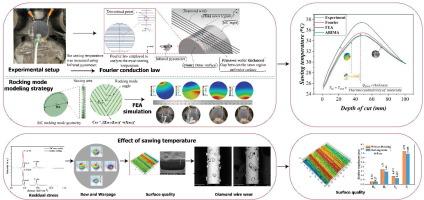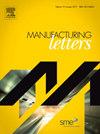Analysis of contact length and temperature effect in rocking mode diamond wire sawing of monocrystalline silicon carbide wafer
IF 2
Q3 ENGINEERING, MANUFACTURING
引用次数: 0
Abstract
Diamond wire sawing (DWS) is a primary and fundamental stage for slicing large-diameter ingots into multiple wafers, enabling high-volume production in a single process. However, the extended contact length between the diamond wire and work material generates heat, which detrimentally impacts the surface quality of the sliced wafers and accelerates the diamond wire wear rate. This study implemented a rocking mode sawing strategy to investigate the effect of contact length on the surface quality of as-sawn wafer and diamond wire wear rate. Experiments have been conducted on monocrystalline silicon carbide (4H-SiC) with and without a rocking-mode multi-DWS machine. The experimental sawing temperature has been validated using Fourier’s law of thermal conduction, a finite element model, and a linear time series regression model. Results indicated that the minimal sawing temperature had been observed with the rocking mode sawing strategy, attributed to its shorter contact length compared to the process without rocking mode. Additionally, the finite element and regression models closely matched the experimental data, achieving accuracies of 93.57 % and 99.96 %, respectively. Fourier’s law of thermal conduction proved significant for precisely determining the sawing temperature. Notably, the rocking mode sawing strategy significantly affected the sawing temperature, surface quality, and diamond wire wear rate compared with the sawing process without the rocking mode.

摇摆模式金刚石线锯切割单晶碳化硅晶片时的接触长度和温度效应分析
金刚石线锯(DWS)是将大直径铸锭切割成多个晶片的主要和基础阶段,可在单一工艺中实现大批量生产。然而,金刚石线与工件材料之间的接触长度延长会产生热量,从而对切片晶片的表面质量产生不利影响,并加快金刚石线的磨损速度。本研究采用摇摆模式锯切策略,研究接触长度对锯切后晶片表面质量和金刚石线磨损率的影响。在使用和不使用摇摆模式多DWS机器的情况下,对单晶碳化硅(4H-SiC)进行了实验。使用傅里叶热传导定律、有限元模型和线性时间序列回归模型对实验中的锯切温度进行了验证。结果表明,与无摇摆模式的工艺相比,摇摆模式锯切策略的接触长度较短,因此锯切温度最低。此外,有限元模型和回归模型与实验数据非常吻合,精确度分别达到 93.57 % 和 99.96 %。事实证明,傅里叶热传导定律对于精确确定锯切温度非常重要。值得注意的是,与无摇摆模式的锯切过程相比,摇摆模式锯切策略对锯切温度、表面质量和金刚石线磨损率有明显影响。
本文章由计算机程序翻译,如有差异,请以英文原文为准。
求助全文
约1分钟内获得全文
求助全文
来源期刊

Manufacturing Letters
Engineering-Industrial and Manufacturing Engineering
CiteScore
4.20
自引率
5.10%
发文量
192
审稿时长
60 days
 求助内容:
求助内容: 应助结果提醒方式:
应助结果提醒方式:


